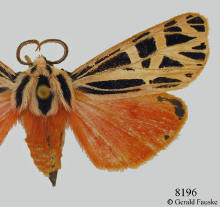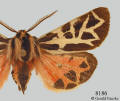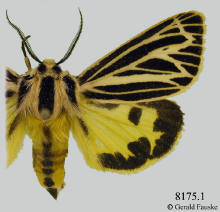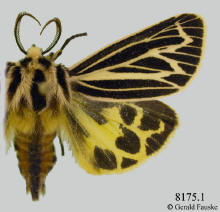| Moths of North Dakota |
Arctiidae: Arctiinae: Arctiini |
The Grammia complex in North Dakota
| In North
Dakota, the genus Grammia can be recognized by the
black and whitish fw pattern in which either the veins are marked with
whitish, or, there is a transverse line crossing the discal cell; many
species possess both of these traits. Specific identifications within
Grammia are the most challenging in the Arctiidae for North Dakota,
consequently, not every specimen is assignable to
species. There are three potential sources of confusion: 1)
Intraspecific variation, 2) Hybridization between species, and 3) Unresolved
taxonomic status of species. Following, is a short discussion of
each of these topics. 1) Intraspecific variation. It has long been known that extremes of cool/wet or hot/dry conditions at critical times in the life cycle of Lepidoptera can affect wing pattern development and expression. In North Dakota, with our continental climate, variant specimens are commonplace. Grammia virgo (top row), may have scarlet or yellow hindwings. The extent of black markings on the hindwings of G. parthenice (bottom row) appears to be related to a moisture gradient from relatively unmarked southwestern specimens to heavily marked individuals from the southeast portion of the state. A separate phenomenon is the extreme reduction of forewing dark markings in the specimen pictured lower left, possibly related to temperature rather than moisture. Finally, hw color may have both a direct genetic component as well as variation due to environmental conditions. Note the yellow hindwings in the far right specimen.
2) Hybridization between species is a second source of variation. The Northern Great Plains, as late as 8- 10,000 y.b.p., was largely under glacial ice, i. e. North Dakota east and north of the Missouri. The unglaciated southwestern portion of the state would at that time have had a drastically different climate than that of present day North Dakota. What this geologic fact has to do with hybridization is this: all [multicellular] species presently occurring in North Dakota are adventive within the last 10,000 years. As such, many species are recently sympatric in the northern plains. Put another way, populations that are coming into contact most recently, occur in the upper Great Plains, and so between such populations (which behave as species elsewhere), isolating mechanisms may not as yet had time to evolve. From left to right, specimens in the top row are: Grammia williamsii, a hybrid, Grammia phyllira, a hybrid, and Grammia parthenice. Similarly, in the North Dakota State Insect Reference Collection there are specimens showing all intergrades between G. virgo and G. parthenice. Pictured in the bottom row are three specimens exhibiting characteristics of more than one Grammia species and not readily assignable to any species. The specimens also show some aberrant forewing maculation. I suspect many of the species in Grammia are of hybrid origin, hybrid swarms which have achieved stability. Traditional hybridization experiments along with mitochondrial DNA analysis might resolve many of the species complexes within Grammia.
3) Unresolved taxonomy is the final source of confusion within this genus. At least two identification problems referable to this category appear in Grammia from North Dakota. First, Grammia speciosa and G. virguncula are a species pair with very similar facies and parallel variation. Traditionally, G. speciosa has been treated as a junior synonym of G. virguncula, Douglas Ferguson (1985) considered them to be good species. The former moth occurs statewide, the latter is apparently confined to the southeast corner of the North Dakota, where not all specimens can be easily assigned to one or the other of these species. Grammia virguncula also occurs in southeastern South Dakota, and a large series of this species is in the NDSIRC from Indiana. In the top row are three G. speciosa showing much of the individual variation found in both species (parallel variation occurs within many noctuoid genera), the fourth specimen is the slightly larger and more orange G. virguncula. The second case of unresolved taxonomy involves the phyllira- oithona- favorita complex. Various authors treat G. oithona as either a good species or as the western population of the eastern G. phyllira. Specimens much like nominate G. phyllira occur in the western half of North and South Dakota and go under the name of G. favorita. The bottom row illustrates a specimen respectively of G. favorita and G. phyllira 'oithona'. Typical G. phyllira is the size of 'oithona' with the maculation of G. favorita.
Key to the species of Grammia occurring in North Dakota (typical specimens).
|
||
|
|



















